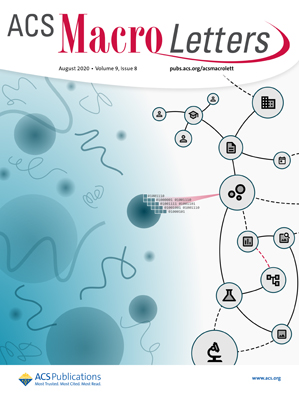通过亲水性网络中两亲共聚物的原位自组装的仿生坚韧和消肿水凝胶
IF 5.1
Q1 POLYMER SCIENCE
引用次数: 0
摘要
受对偶弹性蛋白凝聚(一种由疏水相互作用驱动的弹性纤维形成过程)的启发,我们将两亲性聚乙烯醇-共乙烯(PVA-co-PE)结合到亲水聚(2-羟乙基丙烯酸酯)(PHEA)网络中,开发了一种坚韧、抗膨胀的水凝胶PHEA-(PVA-co-PE)。以含PVA-co-PE的PHEA前体二甲亚砜(DMSO)溶液为原料,经紫外光诱导聚合制备了PHEA-(PVA-co-PE)水凝胶。在溶剂交换过程中,PVA-co-PE在PHEA基体内自组装成胶束结构,模拟了对偶弹性蛋白的凝聚。与PHEA和PVA-co-PE水凝胶相比,PHEA-(PVA-co-PE)的强度分别提高83倍和7倍,韧性分别提高145倍和97倍。该策略可进一步推广到各种两亲共聚物,显示出普遍性。体外和体内实验表明,该水凝胶具有良好的生物相容性和抗肿胀能力。本研究提供了一种简单的方法来开发坚韧、生物相容性和抗肿胀的水凝胶。本文章由计算机程序翻译,如有差异,请以英文原文为准。

Bioinspired Tough and Antiswelling Hydrogel via in Situ Self-Assembly of Amphiphilic Copolymers within a Hydrophilic Network
Inspired by tropoelastin coacervation, a process in elastic fiber formation driven by hydrophobic interactions, we developed a tough, antiswelling hydrogel, PHEA-(PVA-co-PE), by incorporating amphiphilic poly(vinyl alcohol-co-ethylene) (PVA-co-PE) into a hydrophilic poly(2-hydroxyethyl acrylate) (PHEA) network. The PHEA-(PVA-co-PE) hydrogel was prepared by UV-induced polymerization of a PHEA precursor dimethyl sulfoxide (DMSO) solution containing PVA-co-PE, followed by immersion in water. During solvent exchange, PVA-co-PE self-assembled into micellar structures within the PHEA matrix, mimicking the coacervation of tropoelastin. Compared with PHEA and PVA-co-PE hydrogels, the strength of PHEA-(PVA-co-PE) increased by 83 and 7 times, while the toughness increased by 145 and 97 times. This strategy can be further extended to a variety of amphiphilic copolymers, demonstrating the universality. In vitro and in vivo tests demonstrated that the hydrogel possesses excellent biocompatibility and antiswelling capability. This study provides a simple method for developing a tough, biocompatible, and antiswelling hydrogel.
求助全文
通过发布文献求助,成功后即可免费获取论文全文。
去求助
来源期刊
CiteScore
10.40
自引率
3.40%
发文量
209
审稿时长
1 months
期刊介绍:
ACS Macro Letters publishes research in all areas of contemporary soft matter science in which macromolecules play a key role, including nanotechnology, self-assembly, supramolecular chemistry, biomaterials, energy generation and storage, and renewable/sustainable materials. Submissions to ACS Macro Letters should justify clearly the rapid disclosure of the key elements of the study. The scope of the journal includes high-impact research of broad interest in all areas of polymer science and engineering, including cross-disciplinary research that interfaces with polymer science.
With the launch of ACS Macro Letters, all Communications that were formerly published in Macromolecules and Biomacromolecules will be published as Letters in ACS Macro Letters.

 求助内容:
求助内容: 应助结果提醒方式:
应助结果提醒方式:


